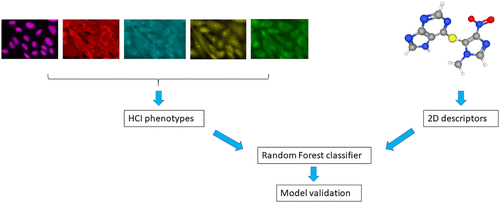当前位置:
X-MOL 学术
›
Chem. Res. Toxicol.
›
论文详情
Our official English website, www.x-mol.net, welcomes your feedback! (Note: you will need to create a separate account there.)
Predicting Chemical-Induced Liver Toxicity Using High-Content Imaging Phenotypes and Chemical Descriptors: A Random Forest Approach.
Chemical Research in Toxicology ( IF 4.1 ) Pub Date : 2020-08-24 , DOI: 10.1021/acs.chemrestox.9b00459 Swapnil Chavan 1 , Nikolai Scherbak 1 , Magnus Engwall 1 , Dirk Repsilber 2
Chemical Research in Toxicology ( IF 4.1 ) Pub Date : 2020-08-24 , DOI: 10.1021/acs.chemrestox.9b00459 Swapnil Chavan 1 , Nikolai Scherbak 1 , Magnus Engwall 1 , Dirk Repsilber 2
Affiliation

|
Hepatotoxicity is a major reason for the withdrawal or discontinuation of drugs from clinical trials. Thus, better tools are needed to filter potential hepatotoxic drugs early in drug discovery. Our study demonstrates utilization of HCI phenotypes, chemical descriptors, and both combined (hybrid) descriptors to construct random forest classifiers (RFCs) for the prediction of hepatotoxicity. HCI data published by Broad Institute provided HCI phenotypes for about 30 000 samples in multiple replicates. Phenotypes belonging to 346 chemicals, which were tested in up to eight replicates, were chosen as a basis for our analysis. We then constructed individual RFC models for HCI phenotypes, chemical descriptors, and hybrid (chemical and HCI) descriptors. The model that was constructed using selective hybrid descriptors showed high predictive performance with 5-fold cross validation (CV) balanced accuracy (BA) at 0.71, whereas within the given applicability domain (AD), independent test set and external test set prediction BAs were equal to 0.61 and 0.60, respectively. The model constructed using chemical descriptors showed a similar predictive performance with a 5-fold CV BA equal to 0.66, a test set prediction BA within the AD equal to 0.56, and an external test set prediction BA within the AD equal to 0.50. In conclusion, the hybrid and chemical descriptor-based models presented here should be considered as a new tool for filtering hepatotoxic molecules during compound prioritization in drug discovery.
中文翻译:

使用高内涵成像表型和化学描述符预测化学诱导的肝毒性:随机森林方法。
肝毒性是药物退出或停止临床试验的主要原因。因此,需要更好的工具在药物发现的早期过滤潜在的肝毒性药物。我们的研究证明了利用 HCI 表型、化学描述符和两种组合(混合)描述符来构建随机森林分类器 (RFC) 来预测肝毒性。Broad Institute 发布的 HCI 数据提供了大约 30 000 个样本的多次重复的 HCI 表型。属于 346 种化学物质的表型被选为我们分析的基础,这些化学物质最多进行八次重复测试。然后,我们为 HCI 表型、化学描述符和混合(化学和 HCI)描述符构建了单独的 RFC 模型。使用选择性混合描述符构建的模型显示出高预测性能,5 倍交叉验证 (CV) 平衡准确度 (BA) 为 0.71,而在给定的适用性域 (AD) 内,独立测试集和外部测试集预测 BA 分别为分别等于 0.61 和 0.60。使用化学描述符构建的模型显示出类似的预测性能,5 倍 CV BA 等于 0.66,AD 内的测试集预测 BA 等于 0.56,AD 内的外部测试集预测 BA 等于 0.50。总之,此处介绍的基于混合和化学描述符的模型应被视为在药物发现中的化合物优先排序期间过滤肝毒性分子的新工具。而在给定的适用性域 (AD) 内,独立测试集和外部测试集预测 BA 分别等于 0.61 和 0.60。使用化学描述符构建的模型显示出类似的预测性能,5 倍 CV BA 等于 0.66,AD 内的测试集预测 BA 等于 0.56,AD 内的外部测试集预测 BA 等于 0.50。总之,此处介绍的基于混合和化学描述符的模型应被视为在药物发现中的化合物优先排序期间过滤肝毒性分子的新工具。而在给定的适用性域 (AD) 内,独立测试集和外部测试集预测 BA 分别等于 0.61 和 0.60。使用化学描述符构建的模型显示出类似的预测性能,5 倍 CV BA 等于 0.66,AD 内的测试集预测 BA 等于 0.56,AD 内的外部测试集预测 BA 等于 0.50。总之,此处介绍的基于混合和化学描述符的模型应被视为在药物发现中的化合物优先排序期间过滤肝毒性分子的新工具。AD内的测试集预测BA等于0.56,AD内的外部测试集预测BA等于0.50。总之,此处介绍的基于混合和化学描述符的模型应被视为在药物发现中的化合物优先排序期间过滤肝毒性分子的新工具。AD内的测试集预测BA等于0.56,AD内的外部测试集预测BA等于0.50。总之,此处介绍的基于混合和化学描述符的模型应被视为一种新工具,用于在药物发现中的化合物优先排序期间过滤肝毒性分子。
更新日期:2020-09-21
中文翻译:

使用高内涵成像表型和化学描述符预测化学诱导的肝毒性:随机森林方法。
肝毒性是药物退出或停止临床试验的主要原因。因此,需要更好的工具在药物发现的早期过滤潜在的肝毒性药物。我们的研究证明了利用 HCI 表型、化学描述符和两种组合(混合)描述符来构建随机森林分类器 (RFC) 来预测肝毒性。Broad Institute 发布的 HCI 数据提供了大约 30 000 个样本的多次重复的 HCI 表型。属于 346 种化学物质的表型被选为我们分析的基础,这些化学物质最多进行八次重复测试。然后,我们为 HCI 表型、化学描述符和混合(化学和 HCI)描述符构建了单独的 RFC 模型。使用选择性混合描述符构建的模型显示出高预测性能,5 倍交叉验证 (CV) 平衡准确度 (BA) 为 0.71,而在给定的适用性域 (AD) 内,独立测试集和外部测试集预测 BA 分别为分别等于 0.61 和 0.60。使用化学描述符构建的模型显示出类似的预测性能,5 倍 CV BA 等于 0.66,AD 内的测试集预测 BA 等于 0.56,AD 内的外部测试集预测 BA 等于 0.50。总之,此处介绍的基于混合和化学描述符的模型应被视为在药物发现中的化合物优先排序期间过滤肝毒性分子的新工具。而在给定的适用性域 (AD) 内,独立测试集和外部测试集预测 BA 分别等于 0.61 和 0.60。使用化学描述符构建的模型显示出类似的预测性能,5 倍 CV BA 等于 0.66,AD 内的测试集预测 BA 等于 0.56,AD 内的外部测试集预测 BA 等于 0.50。总之,此处介绍的基于混合和化学描述符的模型应被视为在药物发现中的化合物优先排序期间过滤肝毒性分子的新工具。而在给定的适用性域 (AD) 内,独立测试集和外部测试集预测 BA 分别等于 0.61 和 0.60。使用化学描述符构建的模型显示出类似的预测性能,5 倍 CV BA 等于 0.66,AD 内的测试集预测 BA 等于 0.56,AD 内的外部测试集预测 BA 等于 0.50。总之,此处介绍的基于混合和化学描述符的模型应被视为在药物发现中的化合物优先排序期间过滤肝毒性分子的新工具。AD内的测试集预测BA等于0.56,AD内的外部测试集预测BA等于0.50。总之,此处介绍的基于混合和化学描述符的模型应被视为在药物发现中的化合物优先排序期间过滤肝毒性分子的新工具。AD内的测试集预测BA等于0.56,AD内的外部测试集预测BA等于0.50。总之,此处介绍的基于混合和化学描述符的模型应被视为一种新工具,用于在药物发现中的化合物优先排序期间过滤肝毒性分子。


























 京公网安备 11010802027423号
京公网安备 11010802027423号